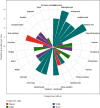Evaluation of Wild, Wine, Table, and Raisin Grapevine (Vitis spp.) Genotypes in Gedeo Zone, Southern Ethiopia
- PMID: 35132309
- PMCID: PMC8817867
- DOI: 10.1155/2022/6852704
Evaluation of Wild, Wine, Table, and Raisin Grapevine (Vitis spp.) Genotypes in Gedeo Zone, Southern Ethiopia
Abstract
Grapevine is one of the major horticultural crops of the world with the cultivated area exceeding 7.5 million ha used for a myriad of products ranging through fresh table grape, preserves, juice, wine, and raisins. The main objective of this study was to introduce twenty-eight grapevine cultivars (ten wild, ten wine, four table, and four raisin grapes) into Gedeo Zone for the first time and ampelographically characterize them in Dilla and Yirgacheffe agroecological conditions in Gedeo Zone, Southern Ethiopia, from August 2018 to July 2021. Ten Vitis abyssinica wild grapevine cultivars were collected from Adama, Addis Ababa, Alamata, Arba Minch, Bahir Dar, Dire Dawa, Gondar, Hawassa, Jimma, and Jinka areas. Additional ten world class wine grapes were gathered from Ziway Castel Winery, and four table and four raisin grapes were also collected from Raya Horti Farm and Koka Vineyard at the same time. The experiment was a 2 × 28 factorial arranged in randomized complete block design (RCBD) with three replications, and data were analyzed using the R-software. The analysis of variance revealed that the interaction of cultivar and location significantly (P < 0.001) affected grapevine plant height, leaf number, number of fruits per plant, and tendril number per vine, while grapevine trunk diameter, flower cluster, root length, and number of suckers per vines were not significantly (P > 0.05) influenced by the interaction of the two factors. Generally, the wine grapevine cultivars had lower canopy such as plant height, leaf number, number of tendrils, and suckering vines while these registered a higher number of fruits per plant, trunk diameter, flower cluster, and root length compared to the wild grapevine cultivars. The results of the present study suggested that Syrah, Chenin Blanc, and Grenache can produce high grapevine berry yield and wine quality in Gedeo Zone agroecology particularly in Dilla location. The wild grapevines collected from Dire Dawa, Arba Minch, Jinka, and Alamata were the potential candidates for the world class wine, raisin, and table grapevines which could open new frontiers in the future for Ethiopian native Vitis abyssinica wild grapevine breeding and genetic engineering that will help to move the national and international viticulture and enology industry forward. As the Ethiopian native grapevines are at the risk of total extinction, adequate conservation strategies are required. Breeding, detailed identification, and introducing the potential grapes in different regions of the country are needed. This finding represents a step forward in efforts to understand hybridization of Vitis abyssinica grapevine with Vitis vinifera and other new world Vitis species.
Copyright © 2022 Dargie Tsegay Berhe and Derbew Belew.
Conflict of interest statement
The authors declare that there are no conflicts of interest.
Figures













Similar articles
-
Impacts of Grapevine Leafroll Disease on Fruit Yield and Grape and Wine Chemistry in a Wine Grape (Vitis vinifera L.) Cultivar.PLoS One. 2016 Feb 26;11(2):e0149666. doi: 10.1371/journal.pone.0149666. eCollection 2016. PLoS One. 2016. PMID: 26919614 Free PMC article.
-
Genetic structure in cultivated grapevines is linked to geography and human selection.BMC Plant Biol. 2013 Feb 8;13:25. doi: 10.1186/1471-2229-13-25. BMC Plant Biol. 2013. PMID: 23394135 Free PMC article.
-
The impact of grapevine red blotch disease on Vitis vinifera L. Chardonnay grape and wine composition and sensory attributes over three seasons.J Sci Food Agric. 2020 Mar 15;100(4):1436-1447. doi: 10.1002/jsfa.10147. Epub 2019 Dec 14. J Sci Food Agric. 2020. PMID: 31742703
-
Oenological potential and health benefits of Chinese non-Vitis vinifera species: An opportunity to the revalorization and to breed new varieties.Food Res Int. 2020 Nov;137:109443. doi: 10.1016/j.foodres.2020.109443. Epub 2020 Jun 15. Food Res Int. 2020. PMID: 33233123 Review.
-
Recent advances in biotechnological studies on wild grapevines as valuable resistance sources for smart viticulture.Mol Biol Rep. 2020 Apr;47(4):3141-3153. doi: 10.1007/s11033-020-05363-0. Epub 2020 Mar 4. Mol Biol Rep. 2020. PMID: 32130616 Review.
Cited by
-
Dynamic Network Biomarker Analysis Reveals the Critical Phase Transition of Fruit Ripening in Grapevine.Genes (Basel). 2022 Oct 13;13(10):1851. doi: 10.3390/genes13101851. Genes (Basel). 2022. PMID: 36292736 Free PMC article.
-
The root transcriptome dynamics reveals new valuable insights in the salt-resilience mechanism of wild grapevine (Vitis vinifera subsp. sylvestris).Front Plant Sci. 2022 Dec 9;13:1077710. doi: 10.3389/fpls.2022.1077710. eCollection 2022. Front Plant Sci. 2022. PMID: 36570937 Free PMC article.
References
-
- Creasy G. L., Creasy L. L. Grapes: Crop Production Science in Horticulture Series . 2nd. Boston, MA, USA: Kindle; 2018.
-
- OIV—International Organization of Vine and Wine. OIV Focus: Vine Varieties Distribution in the World . Paris, France: International Organization of Vine and Wine; 2017.
-
- Piesse J., Conradie B., Thirtle C., Vink N. Efficiency in wine grape production: comparing long-established and newly developed regions of south Africa. Journal of the international Association of Agricultural Economists . 2017;49(2):203–212. doi: 10.1111/agec.12409. - DOI
-
- Foster J. D. In: Grape, Raisin, and Lily Ingestion . Drobatz K. J., Hopper K., Rozanski E., Silverstein D. C., editors. Hoboken, NJ, USA: Wiley; 2018.
-
- OIV—International Organization of Vine and Wine. State of the World Vitivinicultural Sector in 2020 . Paris, France: International Organization of Vine and Wine; 2021.
MeSH terms
LinkOut - more resources
Full Text Sources
Research Materials
Miscellaneous

